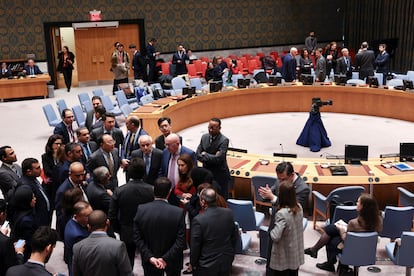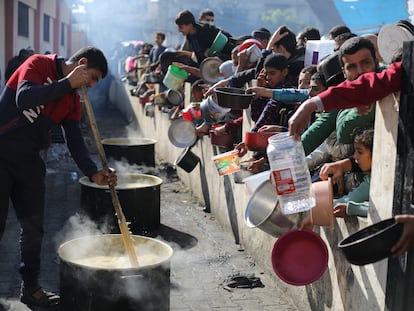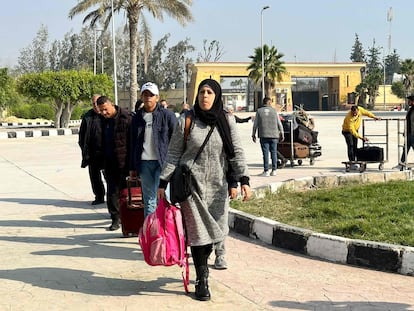Cessation of hostilities, pause, ceasefire? US objections paralyze a resolution on Gaza in the Security Council
Washington rejects the deployment of a U.N. aid monitoring mechanism, the main novelty of the text submitted by the United Arab Emirates


As the days go by, and the war between Israel and Hamas nears its fourth month unabated, the inability of the U.N. to adopt measures to stop the bloodshed in Gaza has highlighted not a deadlock in the Security Council but the United States’ growing isolation in the organization, much like the one Russia has faced since its February 2022 invasion of Ukraine. Washington’s veto of a Security Council draft resolution on a humanitarian ceasefire on December 8, and its opposition to the resolution adopted by a large majority in the General Assembly four days later, have exposed the superpower: in the latter vote, only nine other countries — all of them of little importance in the international community, except Israel — seconded its rejection. As far as the war in Gaza is concerned, the U.S. stands alone before the world, or vice versa.
The Biden administration’s persistent rejection of any measure involving a ceasefire or a cessation of hostilities, even to provide humanitarian aid, has also torpedoed and slowed down the functioning of the Security Council, the body responsible for ensuring world peace and security. In recent days, the body’s normal schedule of meetings and hearings had been modified constantly, and on several occasions the agenda has been disrupted to allow time for negotiations.
On Wednesday, for the third consecutive day, disagreements between the U.S. and the Council’s other members caused the cancellation of a vote on the most recent attempt at a resolution, submitted by the United Arab Emirates. The proposal calls for a cessation of hostilities to allow the delivery of aid to Gazans. The draft resolution also contains a novelty, a control mechanism for the U.N. to supervise the delivery of aid. That inspection appears to be the main sticking point in Wednesday’s negotiations, as the U.S., like Israel, refuses to transfer control of aid inspection to the international organization. Washington has advocated that approach in other conflicts, and humanitarian groups consider it necessary to get supplies to Gazans quickly enough. Israel is reluctant to lose control of that process. Diplomatic sources pointed to the possibility of a new U.S. veto before the postponement of the vote to Thursday was confirmed.
However, on Wednesday, U.S. Secretary of State Antony Blinken said that the U.S. delegation at the U.N. “continues to work broadly and constructively with a number of countries to try to resolve some of the outstanding issues in this Security Council resolution.” Referring to the U.N. oversight mechanism proposed by the United Arab Emirates’ resolution, Blinken stated that “we want to make sure that the resolution… and what it calls for… actually moves that effort forward and doesn’t do anything that would really harm the delivery of humanitarian aid [or] make it more complicated.”

The key points of the text, which has undergone near-constant revision in the last 48 hours, are the call for “an urgent and sustainable cessation of hostilities” to allow the delivery of aid and the immediate deployment of a U.N. monitoring mechanism; in short, it demands “full, rapid, safe and unimpeded humanitarian access” by land, sea and air. The text emphasizes the organization’s deep concern “at the serious and rapid deterioration of the humanitarian situation” in Gaza and its “grave repercussions” on the civilian population in the area, particularly women and children. It also notes the obligation to “respect and protect medical and humanitarian personnel” and demands that the parties comply with their obligations under international law.
Mentioning Hamas and the rejection of a ceasefire
Despite the desperate pleas of Secretary-General António Guterres, who invoked Article 99 of the U.N. Charter to try to force a humanitarian ceasefire, since the war began, the debate has become entangled in a byzantine, or semantic, dispute over the terms of the text. Washington flatly rejects expressions such as “end, pause, interruption of fighting” and disagrees about how aid should be delivered: “corridor” and “humanitarian corridor” are some of the options added to what is now a hypothetical U.N. supervision. As Israel’s voice in the Council, the United States has established two red lines: any mention of a ceasefire or even a cessation of hostilities — if it is described as “sustainable,” “lasting” or “prolonged,” among other terms —, as both countries believe that it would only benefit Hamas; and the addition of an explicit reference to the Hamas attacks of October 7, which started the war. Now, the objections also include a refusal to allow the U.N. to supervise aid deliveries.
The near-final version of the draft that was circulated on Tuesday strongly condemns “all acts of terrorism,” a statement Washington will probably find lukewarm. In addition, the text advocates the two-state solution, stressing the importance of unifying the West Bank and Gaza under the Palestinian Authority (PA). This is another sticking point with Benjamin Netanyahu’s government, which has already stated that it will not allow a PA government in the Gaza Strip. For its part, Washington prefers that option.
Beyond the fierce U.S. defense of its ally in the Middle East, Washington has been left alone in the international community, a fact that contradicts the White House’s commitment to multilateralism after Donald Trump’s four years of isolationism. Israel’s red lines, drawn to the millimeter by the U.S. in the Security Council, may derail the United Arab Emirates’ proposal on Thursday, when it will theoretically be put to a vote. It would be the second time in two weeks that the U.S. representative has exercised a veto, a move that exemplified the country’s international isolation on December 8.
In recent hours, negotiations have intensified between the U.S. and the United Arab Emirates, the driving force behind the resolution. “We are constructively and transparently committed, throughout the process, to reaching a consensus on a text that can be approved,” a member of the U.S. delegation at the U.N. told Reuters late Monday, in typical diplomatic double-talk. But, he added, “the UAE knows exactly what can be approved and what can’t: it’s up to them if they want to get it.”
On December 8, Washington vetoed a Security Council resolution calling for an immediate humanitarian ceasefire between Israel and Hamas. Four days later, the 193-member U.N. General Assembly demanded a ceasefire, with 153 states voting in favor, but unlike in the Security Council, it is not a binding decision.
The blow to U.S. credibility at the U.N. could be definitive if it repeats its veto. A Security Council resolution needs at least nine votes in favor and cannot be vetoed by the United States, France, China, Great Britain or Russia, the five permanent members with veto power in the highest U.N. body. The semantic loop into which the debate has fallen does not inspire much hope for a practical outcome, much less for U.S. willingness to alleviate the suffering in Gaza. Diplomatic sources say that Washington is determined not to undermine Israel’s combat capability with an aid inspection mechanism.
Sign up for our weekly newsletter to get more English-language news coverage from EL PAÍS USA Edition
Tu suscripción se está usando en otro dispositivo
¿Quieres añadir otro usuario a tu suscripción?
Si continúas leyendo en este dispositivo, no se podrá leer en el otro.
FlechaTu suscripción se está usando en otro dispositivo y solo puedes acceder a EL PAÍS desde un dispositivo a la vez.
Si quieres compartir tu cuenta, cambia tu suscripción a la modalidad Premium, así podrás añadir otro usuario. Cada uno accederá con su propia cuenta de email, lo que os permitirá personalizar vuestra experiencia en EL PAÍS.
¿Tienes una suscripción de empresa? Accede aquí para contratar más cuentas.
En el caso de no saber quién está usando tu cuenta, te recomendamos cambiar tu contraseña aquí.
Si decides continuar compartiendo tu cuenta, este mensaje se mostrará en tu dispositivo y en el de la otra persona que está usando tu cuenta de forma indefinida, afectando a tu experiencia de lectura. Puedes consultar aquí los términos y condiciones de la suscripción digital.
More information
Archived In
Últimas noticias
Chris Martin, Taylor Swift, Elijah Wood and other famous wedding ‘crashers’
‘How does it feel to be a failure?’: Elizabeth Berkley’s journey from ‘Showgirls’ ridicule to vindication
The story of the Málaga virus: The code that haunted Google’s cybersecurity center director for 30 years
The impact of Ecuador’s mega-prison: A polluted river, cleared forests and military checkpoints
Most viewed
- Christian Louboutin: ‘Young people don’t want to be like their parents. And if their parents wear sneakers, they’re going to look for something else’
- The low-cost creative revolution: How technology is making art accessible to everyone
- Liset Menéndez de la Prida, neuroscientist: ‘It’s not normal to constantly seek pleasure; it’s important to be bored, to be calm’
- All the effects of gentrification in one corner of Mexico’s Colonia Roma
- December Social Security and SSI payments: Dates, double checks and the 2026 COLA increase










































